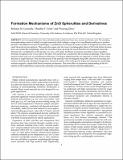Files in this item
Formation mechanisms of ZnO spherulites and derivatives
Item metadata
| dc.contributor.author | Connolly, Bethany | |
| dc.contributor.author | Greer, Heather F. | |
| dc.contributor.author | Zhou, Wuzong | |
| dc.date.accessioned | 2019-12-03T00:37:06Z | |
| dc.date.available | 2019-12-03T00:37:06Z | |
| dc.date.issued | 2019-01-02 | |
| dc.identifier | 257021712 | |
| dc.identifier | 4439117f-62c1-47ec-bf53-16b3dc6a31f4 | |
| dc.identifier | 85058819046 | |
| dc.identifier | 000455076500030 | |
| dc.identifier.citation | Connolly , B , Greer , H F & Zhou , W 2019 , ' Formation mechanisms of ZnO spherulites and derivatives ' , Crystal Growth & Design , vol. 19 , no. 1 , pp. 249-257 . https://doi.org/10.1021/acs.cgd.8b01332 | en |
| dc.identifier.issn | 1528-7483 | |
| dc.identifier.other | ORCID: /0000-0001-9752-7076/work/58055086 | |
| dc.identifier.uri | https://hdl.handle.net/10023/19044 | |
| dc.description | The authors thank EPSRC for a platform grant (EP/K015540/1) and a Capital Equipment Grant EP/L017008/1. | en |
| dc.description.abstract | ZnO microparticles have been solvothermally synthesized from zinc acetate and formic acid. The resulting microspherulites consist of radially arranged nanorods which undergo a range of re-crystallisation pathways to produce particles with different terminal morphologies. Crystallisation on the particle surface results in hex-agonal microdisc decorated hierarchical microspheres. These particles expose only the (0001) crystallographic plane of ZnO and further develop into a sea-urchin like morphology, when the microdiscs grow up along the [0001] direction into hexagonal microrods. Alternatively, crystallisation of the particle core into a ZnO plate, facilitates asymmetric assembly of nanocrystallites, forming a hexagonal cone on one side of the plate. The particle has a mushroom-like terminal morphology. When simultaneous surface and core re-crystallisation takes place, wood gyro-shaped particles are observed, in which all the surface discs face a single direction. The microstructures of the particles were investigated using XRD, electron microscopy and surface colouring with adsorbed charged dyes. Structural studies of the early growth stages and subsequent morphology evolution support a dipole field driven formation mechanism. This work offers an improved understanding of the for-mation of other spherulites, in particular, naturally occurring mineral calcium carbonate spherulites. | |
| dc.format.extent | 9 | |
| dc.format.extent | 2139435 | |
| dc.language.iso | eng | |
| dc.relation.ispartof | Crystal Growth & Design | en |
| dc.subject | QD Chemistry | en |
| dc.subject | NDAS | en |
| dc.subject.lcc | QD | en |
| dc.title | Formation mechanisms of ZnO spherulites and derivatives | en |
| dc.type | Journal article | en |
| dc.contributor.sponsor | EPSRC | en |
| dc.contributor.sponsor | EPSRC | en |
| dc.contributor.institution | University of St Andrews. EaSTCHEM | en |
| dc.contributor.institution | University of St Andrews. School of Chemistry | en |
| dc.identifier.doi | https://doi.org/10.1021/acs.cgd.8b01332 | |
| dc.description.status | Peer reviewed | en |
| dc.date.embargoedUntil | 2019-12-03 | |
| dc.identifier.url | https://doi.org/10.1021/acs.cgd.8b01332.s001 | en |
| dc.identifier.grantnumber | EP/K015540/1 | en |
| dc.identifier.grantnumber | ep/l017008/1 | en |
This item appears in the following Collection(s)
Items in the St Andrews Research Repository are protected by copyright, with all rights reserved, unless otherwise indicated.

